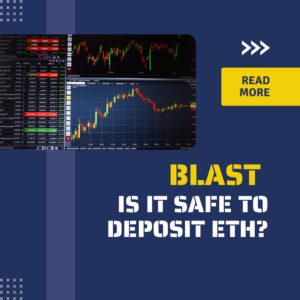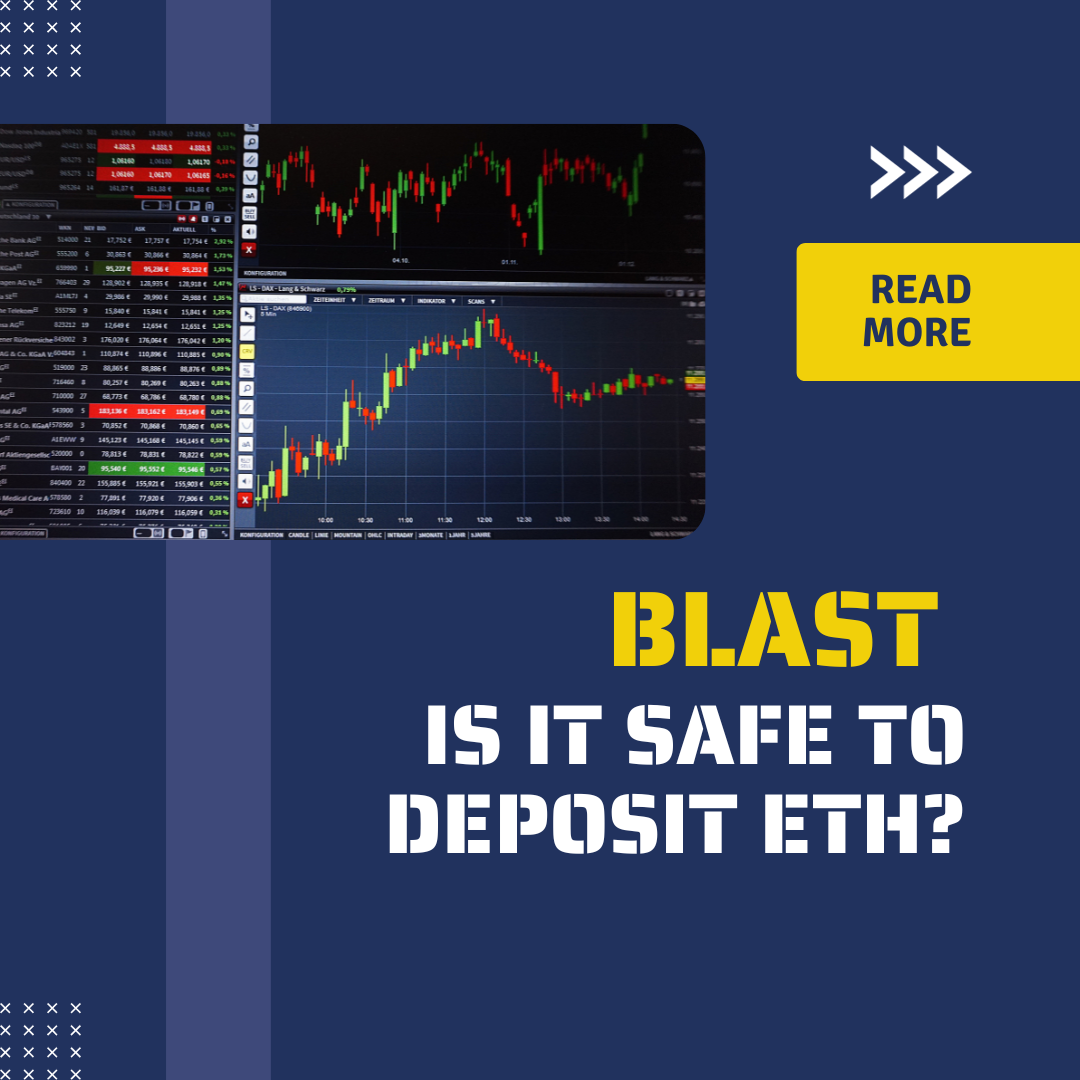The world of blockchain and cryptocurrency is ever-evolving, marked by innovations that seek to address the challenges faced by existing technologies. One such recent development is Blast, the latest Ethereum Layer 2 (L2) network, which has captured the attention of investors and crypto enthusiasts alike. In this comprehensive article, we delve into the intricacies of Blast, exploring its unique features, the surge of funds it has witnessed, and, most importantly, addressing the paramount question: Is it safe to deposit ETH in Blast?

Blast emerges as a promising advancement in the realm of Layer 2 solutions, operating atop existing blockchains like Ethereum to alleviate issues related to speed, cost, and scalability. As the crypto community seeks alternatives to enhance transaction efficiency, Blast enters the stage as a potential game-changer.
Key Takeaways
- Rapid Influx of Funds: Investors swiftly injected over $30 million in ether and stablecoins into Blast shortly after its launch, signaling confidence in its potential.
- Unique Design and Features: Blast’s appeal lies in its distinctive design, allowing depositors not only to transfer ether but also to earn yields alongside BLAST points. The platform’s native participation in ETH staking adds an extra layer of functionality.
- Operational Details: Blast’s ground-up redesign promises a seamless experience for users, with assets automatically growing over time. Withdrawals and on-chain activities are slated for availability only after the mainnet launch in February, and the platform operates on an invite-only basis.
- @PacmanBlur’s Vision: @PacmanBlur, a prominent figure in the crypto space and founder of the popular NFT marketplace Blur, sees Blast as an extension of the Blur ecosystem, enabling users to generate returns from dormant assets.
Blast: Is It Safe to Deposit ETH?
The surge of funds into Blast signals high interest and confidence from investors. However, the crucial question remains: Is it safe to deposit ETH in Blast? To answer this, we explore various aspects of Blast’s security measures, its underlying technology, and the overall risk factors associated with Layer 2 networks.
Security Measures in Blast
- Code Audits: Thorough code audits are crucial for the security of any blockchain platform. Has Blast undergone external audits by reputable firms? Investors should seek transparency to gauge the platform’s commitment to security.
- Smart Contract Security: The core functionality of Blast relies on smart contracts. Has Blast conducted rigorous testing and auditing of its smart contracts to prevent exploits or vulnerabilities?
- Decentralization: The degree of decentralization in Blast’s network is critical for assessing its security. Understanding the distribution of nodes and governance mechanisms within Blast will shed light on its overall security posture.
Technology Underpinning Blast
- Layer 2 Technology: Different Layer 2 technologies have varying implications for security, scalability, and interoperability. Understanding the specific Layer 2 technology employed by Blast is essential.
- Consensus Mechanism: Blast’s consensus mechanism plays a pivotal role in maintaining the integrity of its network. Investors should assess the security implications and trade-offs associated with the chosen mechanism.
Risk Factors in Layer 2 Networks
- Security Trade-offs: While Layer 2 solutions aim to enhance scalability and reduce transaction costs, they often involve security trade-offs. Understanding the specific trade-offs made by Blast is crucial for investors.
- Centralization Risks: Some Layer 2 networks might exhibit tendencies toward centralization. Investors should evaluate the level of decentralization in Blast to gauge potential risks.
- Mainnet Launch Risks: The fact that withdrawals and full functionality are scheduled for the mainnet launch introduces a degree of uncertainty. Investors should be aware of the risks associated with deploying funds in a network that is still in its early stages.
FAQS
How does Blast integrate with existing Ethereum infrastructure, and what benefits does it offer to users and dApps?
Blast integrates seamlessly with the Ethereum ecosystem, operating as a Layer 2 solution. Its primary benefit lies in reimagining how yield-bearing assets interact with wallets and decentralized applications (dApps). By allowing native yield on ETH and stablecoins, Blast optimizes capital efficiency. For users, this means automatic asset growth, turning wallets into savings accounts, and dApp TVLs generating revenue.
Can you elaborate on the strategic backers supporting Blast, such as Paradigm and Standard Crypto?
Blast received significant backing, with a round led by reputable investors like Paradigm and Standard Crypto. These backers recognize the potential of Blast in reshaping Layer 2 infrastructure and contributing to the growth of the crypto ecosystem. The involvement of strategic backers not only provides financial support but also signifies confidence in Blast’s vision and the leadership of @PacmanBlur.
What impact does Blast’s design have on existing AMM pools and NFT marketplaces within the Ethereum ecosystem?
Blast’s design, with its native yield on ETH and stablecoins, has a transformative impact on existing Automated Market Maker (AMM) pools and Non-Fungible Token (NFT) marketplaces. Capital within these pools becomes efficient, and users can capture yields directly from their holdings without the need for additional actions. This redesign influences the way basic building blocks, like Uniswap pools, are conceived, fostering efficiency and innovation.
What potential challenges might users face during Blast’s invite-only phase, and how can they navigate them?
Challenges during the invite-only phase may include limited accessibility and the need for an invitation code. Users can navigate these challenges by actively engaging with Blast’s official communication channels, participating in community discussions, and staying informed about updates. The invite-only approach emphasizes the importance of community involvement, allowing users to contribute to the shaping of Blast’s development.
How does Blast’s connection to the Blur ecosystem enhance its value proposition, and what benefits does it bring to users of both platforms?
Blast is an extension of the Blur ecosystem, led by @PacmanBlur. This connection enhances its value proposition by allowing Blur users to earn yields on idle assets while improving technical aspects for advanced NFT products. The synergy between Blast and Blur creates a comprehensive ecosystem where users can seamlessly transition between platforms, maximizing their crypto experience.
Conclusion: Navigating the Risks
As with any investment in the crypto space, depositing ETH in Blast involves navigating a landscape of potential risks and rewards. While the surge in funds and the unique features of Blast are promising, investors must exercise due diligence and caution.
Blast’s success will depend on its ability to address security concerns, maintain a decentralized infrastructure, and deliver on its promises. Investors should closely monitor developments, code audits, and community feedback to stay informed about the platform’s progress and any emerging risks.
In the ever-evolving crypto ecosystem, embracing innovation comes with a responsibility to stay informed and vigilant. As Blast pioneers a new frontier in Layer 2 solutions, investors are advised to tread carefully, weighing the potential benefits against the inherent risks, and make decisions aligned with their risk tolerance and investment objectives.
Read More:
A Step-by-Step Guide to Crypto Sports Betting – Tricky Finance
The Taxation of Cryptocurrency: What You Need to Know – Tricky Finance
How Crypto Is Bouncing Back – Tricky Finance
Princy Agarwal, a postgraduate in English from Delhi University, writes content for Tricky Finance, where they simplify complex financial topics for readers. With a knack for clear communication, Princy’s work helps make finance understandable and accessible to all.




